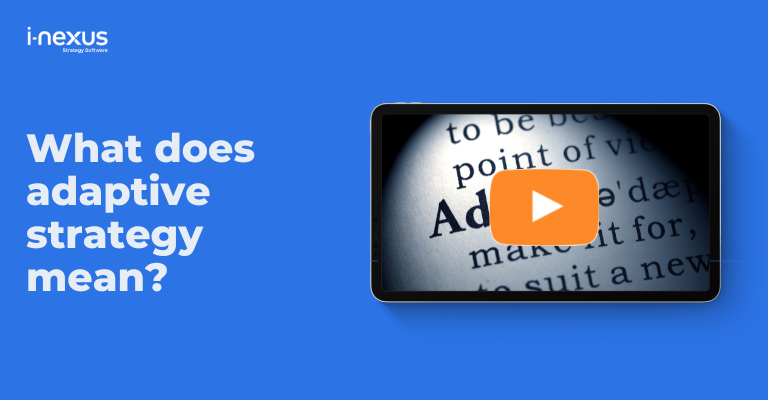As Artificial Intelligence (AI) becomes a mainstay in our lives, how can AI and machine-assisted learning evolve to support your Strategy Execution?
Written by: James Davies, Executive Vice President of Product
Artificial Intelligence (AI) remains a popular concept in many business circles. Indeed, much can be said about its applications, and therefore benefits, across all industries. From medicine and marketing, to finance and HR.
As a senior leader in your organization, the phrase “AI” likely features in conversations about IT and finance. In 2020 it will be part of discussions around strategic, transformational and operational activities. So, the question remains, how can AI evolve to support this?
AI and Strategy Execution
Indeed, automating functions that are time and resource-intensive is a popular use case for AI today.
There is great value to be had from applying even basic functionality to business processes.
Automation alone is predicted to save businesses between 40 to 75 per cent of their daily running costs, according to KPMG's Managing Director of Digital Labor / Robotic Process Automation.
Eventually, however, it will move beyond this.
In Strategy Execution, AI will begin to work as a virtual support team: advising, analyzing, flagging risks and predicting performance.
The result is an intelligent system which acts as a strategic partner, researcher and virtual consultant.
But first, we must get there.
To this end, it pays to consider the lessons of the past, enabling us to understand what you and your organization can expect from machine-assisted Strategy Execution now and in decades to come.
What are the different types of AI?
The types of AI today and tomorrow look very different.
Before we explore its opportunities, we should unpick some of the terminology and jargon that abound in the space.
Machine learning
This is a subset of AI where a computer ‘learns’ how to complete a task without being explicitly programmed. It’s therefore limited to completing one or two activities.
An example could be sending a welcome email when a customer signs up to a newsletter, or sending a churn message when they haven’t been active for a while.
Deep learning
Deep learning is a version of AI inspired by the structure and function of the brain. It uses interconnected ‘neurons’ to complete more complex tasks.
Neural networks
Neural networks are closely linked to deep learning. Algorithms mimic the biological structure of the brain to primarily recognize different patterns.
Narrow AI
Narrow AI involves an AI outperforming humans in a narrowly defined task. It focuses on doing one or two things well, such as image recognition or voice recognition.
General AI
General AI is where an AI can function like a human. In other words, it can learn, perceive, understand and build competencies like a human, reflecting our multi-functional capabilities.
Artificial superintelligence
Artificial superintelligence systems will go beyond human capabilities to be better at everything they complete. This is thanks to their overwhelmingly greater memory, faster data processing and analysis and superior decision-making capabilities.
Examples of AI
With the exponential growth of AI, there are some noteworthy examples that prove not only the power of technology, but also how it has become almost common place in our daily lives.
a) Amazon Alexa
Amazon’s virtual assistant, Alexa, has found its way into the homes and workspaces of more than 100 million people.
For assistants such as Alexa to not only survive, but thrive, requires the technology to comprehend what its user is saying to it.
To do so requires machine learning, and the more Alexa learns, the greater role it can play in supporting you.
b) Uber
The epitome of challenger, disruptor and innovator, Uber’s modern taxi service has stormed its market with its inexpensive and safe solution.
Looking deeper we can see that AI and machine learning are playing a tremendous role in its success.
AI and machine learning drive Uber’s calculations around fare prices, arrival time and routes.
c) IBM's Watson
IBM’s Watson uses cognitive computing to support businesses across industries such as finance to make use of insights which support timely, risk-sensitive decision making.
Originally designed to compete against the champions of quiz game-show Jeopardy!, its use has reached far beyond this, using deep learning for truly remarkable outcomes.
d) The MIT Cheetah 4
A somewhat peculiar example, but one that has an eye on the future more than present.
For now, MIT’s four-legged robot has the motion of a gymnast, is seemingly indestructible, and has made plenty of headlines as a breakthrough in robotics.
While current use is quite limited, there are camps who argue that the technology behind MIT’s Cheetah 4 can eventually support with construction site work, particularly the carrying of heavy loads.
e) Driverless cars
Self-driving vehicles are a good example of general AI.
They must work safely and make life-or-death decisions about road conditions, passenger and pedestrian behavior and other vehicles. This requires computation of factors, rules and options.
It’s predicted that we’ll reach this level between 2030 to 2060 - that's within most people’s lifetimes.
The current capabilities of AI
General AI and superintelligence do not yet exist, but companies such as Google, IBM, Apple and Facebook are investing significant sums in developing AI.
The UK Telegraph reported that $1 billion was invested in UK AI companies in the first half of 2019.
“The playing field is poised to become a lot more competitive, and businesses that don’t deploy AI and data to help them innovate in everything they do will be at a disadvantage.”
Paul Daugherty, Chief Technology and Innovation Officer, Accenture
And one glance at the companies and industries investing in AI technology demonstrates the worth of AI in the Fourth Industrial Revolution.
Google bought AI start-up DeepMind for $400 million, IBM is continuously developing Watson, meanwhile, Amazon has Alexa and AI-powered grocery store Amazon Go.
Most of what we identify as AI today falls under the ‘narrow AI’ category - powered through machine or deep learning. It focuses primarily on descriptive and basic predictive functions.
In the future, these will evolve into cognitive functions based on general AI. This ensures a machine can better advise and consult on projects.
Will humans still have a role in the evolution of Strategy Execution?
It’s worth stating at this point, however, that a human will always be in control in machine-assisted Strategy Execution.
The stakes for an organization are too high to solely put a machine in charge.
A strategy charters the course (and success) of the entire business. Plus, it requires a degree of human creativity and intuition.
Early building blocks
Instead, AI in Strategy Execution will work to amplify human knowledge and understanding. A concept that was first conceived in 1945 in Vannevar Bush’s ‘As We May Think’.
Our understanding of AI is rooted in the works of John McCarthy and Alan Turing (along with Hollywood plotlines).
AI was coined by McCarthy in 1956. In 1950, Turing surmised a time when machines could simulate human activities like playing chess. This idea laid the foundation to the Turing Test, which tests machines for human-like intelligence.
Machine learning, as we know it, was born in the sixties along with Machine Vision Learning. Robotics appeared in the 1970s with the Japanese invention WABOT-1 (seen below).But then, frustrated by the pace of development and investment returns, and stymied by a lack of data, the AI Winter occurred. This didn’t break until the 1990s when US organizations became interested in AI. The cause? Partly the technology becoming a Hollywood hit - capturing the public’s imagination.
Several breakthroughs followed, including IBM’s computer Deep Blue beating Garry Kasparov, then world chess champion, during a six-game match that lasted several days.
The machine learning powering this defines much of the technology in use today. Pushing forward a computer’s ability to handle complex calculations, carry out large database searches, do financial modeling and track trends.
Big Data and AI
Data is integral to AI. Without it, a machine will not learn or operate effectively.
General AI and superintelligence will become impossible milestones.
Today’s organizations collect a mountain of data. Data from daily operations will help AI to determine trends and understand future success.
The average enterprise has 347 terabytes of data at its disposal, a number set to grow exponentially in the data-heavy Fourth Industrial Revolution.
Consequently, the world’s most data-rich companies such as Google and Amazon are frontrunners in the AI race.
AI will leap forward again, with increases in computing power and storage also driving momentum. AI will evolve to where it supports applications across the entire strategy planning and deployment spectrum.
However, the quality of data remains paramount, as identified by Trifacta CEO Adam Wilson:
"Machine learning, AI and analytics have become the primary growth opportunities...[yet] it's this same growth that is causing barrier to success as AI projects overwhelmingly face the same problem -- data quality."
Businesses must connect their data sets, creating a single source of truth of their performance.
From descriptive to prescriptive
As AI makes this change, the value generated by it will grow, making it an increasingly attractive and vital proposition for all businesses.
It has the potential to generate an additional $2.6 trillion in value by 2020, solely in marketing and sales, plus a further $2 trillion in manufacturing and supply chain planning.
By 2022, the global spend on AI and cognitive intelligence systems will hit $77.6 billion.
For today’s senior leaders, understanding the current opportunities and limitations is key.
We are in a time where AI can tell us what’s happening, give insight on why it’s happening and predict what could happen, functions that already hold a lot of value for organizations.
Horizon scanning, for instance, is more efficient with an AI assisting.
Instead of a human spending countless hours tracking a subset of external factors, a machine can monitor everything. That includes informing you of risks to your Strategy Execution, and allowing you to proactively pivot.
The onus is on researchers and business leaders to unite in pushing machine-assisted Strategy Execution onwards.
Ultimately, machine-assisted Strategy Execution will be a reality in every leader’s near future. Those that make the effort to understand it, and who track R&D efforts in the sector, will avoid becoming a historical footnote.
What next steps should your business take?
As the evolution of AI and machine-assisted learning picks up pace, we recommend understanding the bigger picture of digital transformation in regards to your strategic, transformational and operational goals as a business.
Click here to visit our Strategy Execution Management knowledge hub, filled with content to support you in embracing the 'no normal' of strategy in the 2020s and beyond, or explore these recommendations:
- Adaptive Strategy - the future of delivering strategic value at pace?: Watch our latest webinar addressing the future of strategic planning, program deployment and portfolio optimization for value delivery at pace.
- The key to Strategy Execution: Uncover the benefits of excellent Strategy Execution, the organizations who have succeeded, and how your business can follow suit.
About the author
James Davies is i-nexus’ Executive Vice President of Product. As an experienced software executive with 20 years of experience working in Silicon Valley, USA, James has held senior leadership roles in three venture capital-backed software start-ups (including CEO, CPO and Chairman) and has delivered management consulting services to some of the world’s largest technology companies.
If you’d like to talk more about the future of Strategy Execution, reach out to him on james.davies@i-nexus.com or connect with James on LinkedIn for the latest Strategy Execution insights.



